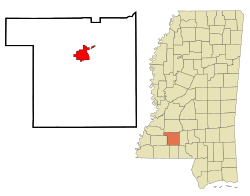Brookhaven, Mississippi facts for kids
Quick facts for kids
Brookhaven, Mississippi
|
|||
|---|---|---|---|

Brookhaven City Hall
|
|||
|
|||

Location of Brookhaven, Mississippi
|
|||
| Country | United States | ||
| State | Mississippi | ||
| County | Lincoln | ||
| Area | |||
| • Total | 21.73 sq mi (56.28 km2) | ||
| • Land | 21.64 sq mi (56.05 km2) | ||
| • Water | 0.09 sq mi (0.23 km2) | ||
| Elevation | 489 ft (149 m) | ||
| Population
(2020)
|
|||
| • Total | 11,674 | ||
| • Density | 539.41/sq mi (208.27/km2) | ||
| Time zone | UTC-6 (Central (CST)) | ||
| • Summer (DST) | UTC-5 (CDT) | ||
| ZIP codes |
39601-39603
|
||
| Area code(s) | 601 | ||
| FIPS code | 28-08820 | ||
| GNIS feature ID | 0667590 | ||
Brookhaven is a city in Lincoln County, Mississippi, United States. It is about 55 miles (88 km) south of Jackson, the state capital. In 2020, about 11,674 people lived there. Brookhaven is the main city, or county seat, of Lincoln County. It was named by its founder, Samuel Jayne, in 1818. He named it after the town of Brookhaven, New York.
Contents
History of Brookhaven
Brookhaven is located on land that once belonged to the Choctaw Indian people. Samuel Jayne, who came from New York, founded the city in 1818. He named it after a town on Long Island called Brookhaven.
In 1858, a railroad line was built through Brookhaven. This railroad connected the city to New Orleans in the south and Memphis in the north.
During the American Civil War, Union soldiers briefly took over Brookhaven on April 29, 1863. A group of Union cavalry led by Colonel Benjamin Grierson burned public buildings. They also destroyed the railroad tracks. The railroad was later rebuilt after the war ended.
In 1936, Brookhaven was chosen as the location for the Stahl-Urban garment plant. This factory made clothes.
In 1955, Lamar Smith, a black farmer and World War I veteran, was killed in Brookhaven. He was an important civil rights figure. He worked to help black people register to vote.
Geography of Brookhaven
Brookhaven covers a total area of about 7.3 square miles (18.9 km2). Most of this area is land, with a small amount of water.
In 2007, the city of Brookhaven grew much larger. It almost tripled its size by adding nearby suburban areas. This change helped to make sure that everyone in the expanded area received the same city services and paid similar taxes.
Population and People
| Historical population | |||
|---|---|---|---|
| Census | Pop. | %± | |
| 1860 | 996 | — | |
| 1870 | 1,614 | 62.0% | |
| 1880 | 1,615 | 0.1% | |
| 1890 | 2,142 | 32.6% | |
| 1900 | 2,678 | 25.0% | |
| 1910 | 5,293 | 97.6% | |
| 1920 | 4,706 | −11.1% | |
| 1930 | 5,288 | 12.4% | |
| 1940 | 6,232 | 17.9% | |
| 1950 | 7,801 | 25.2% | |
| 1960 | 9,885 | 26.7% | |
| 1970 | 10,700 | 8.2% | |
| 1980 | 10,800 | 0.9% | |
| 1990 | 10,243 | −5.2% | |
| 2000 | 9,861 | −3.7% | |
| 2010 | 12,513 | 26.9% | |
| 2020 | 11,674 | −6.7% | |
| U.S. Decennial Census | |||
2020 Census Information
| Race | Number of People | Percentage |
|---|---|---|
| White (not Hispanic) | 4,439 | 38.02% |
| Black or African American (not Hispanic) | 6,710 | 57.48% |
| Native American | 15 | 0.13% |
| Asian | 117 | 1.0% |
| Pacific Islander | 2 | 0.02% |
| Other/Mixed | 266 | 2.28% |
| Hispanic or Latino | 125 | 1.07% |
In 2020, Brookhaven had 11,674 people living in the city. There were 4,346 households and 2,827 families.
2010 Census Information
In 2010, Brookhaven had 12,513 people. The city had 4,768 households. The population density was about 1,714 people per square mile (658.6/km2).
The people living in Brookhaven were mostly White (43.8%) and African American (54.1%). There were also smaller groups of Native American, Asian, and people of two or more races. About 0.9% of the population was Hispanic or Latino.
Many households (34.9%) had children under 18 living with them. The average household had about 2.48 people.
Arts and Culture
Brookhaven is home to Temple B'nai Shalom. This building is an example of Moorish Revival architecture. This style of building has designs inspired by ancient Moorish art.
Education in Brookhaven
The Brookhaven School District runs the public schools in the city. For many years, there were separate schools for black students and white students. This was due to segregation laws.
In 1954, the Supreme Court ruled that separate schools were illegal. This ruling was called Brown v. Board. However, it took time for schools in Mississippi to integrate. By 1970, public schools in Brookhaven became desegregated. Some private schools, like Brookhaven Academy, were started during this time.
In 1988, there was a disagreement when Brookhaven High School hired a new football coach. Some people felt the hiring was unfair. This led to a school boycott by some students and families. The coach's hiring was eventually changed.
The Mississippi School of the Arts is also located in Brookhaven. This is a special high school for talented students from all over the state. It focuses on arts education.
Several other public schools in Lincoln County are in the rural areas around Brookhaven. These include Bogue Chitto Attendance Center, Enterprise Attendance Center, Loyd Star Attendance Center, and West Lincoln Attendance Center.
Whitworth Female College was an all-girls college founded in Brookhaven in 1858. It closed its doors in 1984.
In 2019, reports noted that classrooms in the school district still had many students of one race. Some classrooms were mostly black, and some were mostly white.
Media
Brookhaven is part of the Jackson, Mississippi television market. This means people in Brookhaven can watch news from stations like WLBT, WJTV, WAPT, and WDBD. The city also has its own daily newspaper called The Daily Leader.
Transportation
Roads
Major roads run through Brookhaven. These include Interstate 55 and U.S. Route 51. Both of these roads go north and south. U.S. Route 84 runs east and west through the city.
Rail Transportation
Amtrak's famous train, the City of New Orleans, stops in Brookhaven. This train travels north and south on old railroad lines. The train was even the subject of a popular song.
Famous People from Brookhaven
- Lance Dwight Alworth, a well-known American football player.
- Elsie Barge, a talented pianist and music teacher.
- Jim C. Barnett, a doctor and surgeon who served in the Mississippi House of Representatives.
- Jim Brewer, a blues musician.
- Corey Dickerson, a professional baseball player.
- Bernard Ebbers, a former CEO of WorldCom.
- Charles Henri Ford, a poet, writer, filmmaker, and artist.
- Ruth Ford, an actress.
- Cindy Hyde-Smith, a U.S. Senator from Mississippi.
- Earsell Mackbee, a football player.
- Garry Owen, a film actor.
- Robert W. Pittman, who helped create MTV.
- Lulah Ragsdale, a poet, writer, and actor.
- David Banner, a rapper.
- Richard Scruggs, a lawyer.
- J. Kim Sessums, an artist.
- Lamar Smith, a civil rights activist.
- Guy Turnbow, a football player.
- Addie L. Wyatt, an important leader in the U.S. labor movement and civil rights. She was named a "Person of the Year" by Time magazine in 1975.
See also
 In Spanish: Brookhaven (Misisipi) para niños
In Spanish: Brookhaven (Misisipi) para niños





